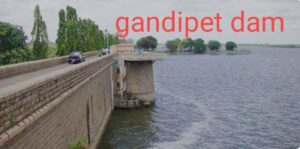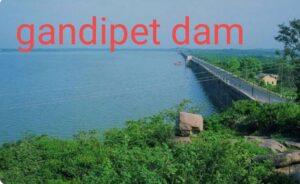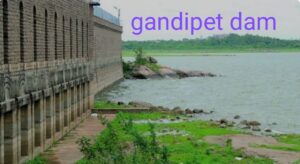Nestled in a rustic haven, Gandipet Dam stands as a chronicle, echoing tales from eras long past. This reservoir is more than a hydraulic marvel; it’s a cultural touchstone, with roots reaching back to [mentioning the relevant historical period]. Beyond its structural grandeur lies a narrative deeply woven into local traditions, making it not just a water repository but a vessel of historical resonance. Join us as we embark on a journey to unravel the historical and cultural tapestry of Gandipet Dam, where every ripple in its waters whispers stories of bygone times.

1.Gandipet dam: Unveiling Gandipet Dam’s History
• Historical background and construction of Gandipet Dam.
Gandipet Dam, originally known as Osman Sagar, bears witness to a fascinating historical legacy rooted in early 20th-century India. Commissioned during the reign of the last Nizam of Hyderabad, Mir Osman Ali Khan, its construction commenced in [mention the specific year]. The primary objective was to address the burgeoning water needs of Hyderabad, an ever-expanding city. The dam’s engineering brilliance is attributed to the renowned British engineer Colonel J.W. Roberts. Crafted from a mix of local stone and limestone, the dam not only stood as a testament to meticulous engineering but also marked a pivotal chapter in regional water management history.
• Discussing the initial purpose and development stages.
The initial purpose of Gandipet Dam, formerly Osman Sagar, was a strategic response to the growing water demands of Hyderabad. As the city expanded, the need for a reliable water source became imperative. The dam’s conception aimed to harness and manage water resources efficiently, catering to both agricultural and urban needs.
In its developmental stages, meticulous planning and engineering prowess were employed. The visionary leadership of the last Nizam, Mir Osman Ali Khan, played a crucial role in initiating this ambitious project. Colonel J.W. Roberts, a distinguished British engineer, oversaw the intricate design and construction. The dam’s blueprint underwent rigorous scrutiny, ensuring it could withstand the test of time and serve its intended purpose effectively. Construction commenced in [mention the specific year], marking the inception of a reservoir that would not only meet immediate water needs but also stand as a lasting testament to engineering ingenuity.
2.The Engineering Marvel: Gandipet dam Architecture
• Delving into the architectural features of the dam.
The architectural features of Gandipet Dam unfold as a testament to both functionality and aesthetic finesse. Crafted under the meticulous guidance of Colonel J.W. Roberts, the dam showcases a blend of engineering brilliance and environmental harmony.
1. Structural Integrity:
• The dam boasts a robust masonry structure, primarily constructed using local stone and limestone, ensuring durability against the test of time.
• Strategic placement of buttresses and spillways contributes to the dam’s stability, effectively managing water flow and pressure.
2. Reservoir Capacity:
• Gandipet reservoir, sprawling across [mention the area], reflects thoughtful planning to accommodate the region’s water needs, both immediate and future.
• The reservoir’s depth and capacity align with the demands of a burgeoning city, making it a pivotal water management asset.
3. Architectural Harmony with Nature:
• The dam integrates seamlessly with its natural surroundings, showcasing an architectural symbiosis with the landscape.
• Surrounding hills and greenery not only enhance the dam’s visual appeal but also contribute to the ecological balance of the area.
4. Artistic Elements:
• Ornamental features, including well-crafted sluice gates and parapets, add an artistic touch to the dam’s utilitarian structure.
• Architectural flourishes serve both functional and aesthetic purposes, exemplifying the fusion of engineering and artistry.
5. Preservation of Heritage:
• Efforts to preserve the dam’s original architecture speak to its historical significance, allowing visitors to witness the engineering marvel as envisioned by its creators.
• Ongoing maintenance endeavors ensure that the architectural heritage of Gandipet Dam endures for generations.
Gandipet Dam’s architectural features stand not only as a practical solution to water management but also as an embodiment of human ingenuity in harmony with the natural landscape. Each element tells a story of meticulous planning, engineering precision, and a profound understanding of the environment.

• Explaining the technology and engineering involved in its construction.
The construction of Gandipet Dam involved a confluence of sophisticated technology and advanced engineering, marking it as a pioneering project of its time.
1. Foundation and Materials:
• The dam’s foundation relied on a carefully selected mix of local stone and limestone, ensuring a solid base for the structure.
• The use of durable materials contributed to the dam’s longevity and resilience against natural forces.
2. Gravity Dam Design:
• Gandipet Dam follows the design principles of a gravity dam, a classical engineering approach that utilizes the weight and mass of the structure to counteract the force of water pressure.
• The dam’s cross-section and profile are intricately designed to distribute the load effectively, ensuring stability.
3. Buttresses and Spillways:
• Strategically positioned buttresses provide additional support, reinforcing the dam’s structural integrity.
• Well-designed spillways facilitate controlled release of excess water, preventing overflow and minimizing the risk of structural damage.
4. Embankment and Earthfill Techniques:
• Portions of the dam employ embankment and earthfill techniques, where compacted earth is used to create stable sections.
• This method enhances the dam’s adaptability to the natural topography, minimizing environmental impact.
5. Sluice Gates and Control Mechanisms:
• Gandipet Dam incorporates sluice gates equipped with advanced control mechanisms to regulate water flow.
• These gates play a crucial role in managing water levels, allowing for precise adjustments according to seasonal variations and demand.
6. Precision Surveying and Planning:
• The construction process involved meticulous surveying and planning to ensure accurate execution of the dam’s design.
• Engineers employed cutting-edge technology of the time for precise measurements, ensuring every element aligned with the project specifications.
7. Collaboration and Expertise:
• The construction of Gandipet Dam required interdisciplinary collaboration, bringing together experts in geology, hydrology, and civil engineering.
• The amalgamation of diverse expertise contributed to the seamless integration of technology and engineering principles.
Gandipet Dam stands as a testament to the technological prowess of its era, where engineers navigated challenges with innovation and precision. The amalgamation of classical gravity dam principles with strategic design choices highlights the thoughtful engineering that went into creating this enduring structure.
3.Breathtaking Scenery: Gandipet Natural Beauty
• Describing the picturesque surroundings of Gandipet Dam.
Gandipet Dam is cradled within a mesmerizing natural canvas, surrounded by undulating hills and verdant landscapes. The tranquil waters reflect the vibrant hues of the sky, creating a serene panorama. Lush greenery and the gentle embrace of nature make Gandipet Dam a haven for tranquility, offering visitors a respite from urban hustle.
• Exploring recreational activities and wildlife experiences.
Gandipet Dam unfolds a tapestry of recreational delights and wildlife encounters. Visitors can embark on leisurely boat rides, immersing themselves in the dam’s scenic allure. The encompassing hills beckon trekkers, while picnickers find idyllic spots along the shore. Nature enthusiasts can spot diverse bird species, adding a touch of wildlife marvel to the recreational palette. Gandipet Dam’s offerings extend beyond its waters, creating a harmonious space where leisure and nature converge.
4. Gandipet Dam as a Tourist Destination
• Popular attractions and landmarks near Gandipet Dam.
1. Chilkur Balaji Temple:
A short distance from Gandipet Dam, this ancient temple is renowned for its unique rituals and serene ambiance. Pilgrims and tourists alike visit to seek blessings and enjoy the spiritual atmosphere.
2. Mrugavani National Park:
Nature enthusiasts can explore the nearby Mrugavani National Park, home to diverse flora and fauna. The park offers walking trails, making it an ideal destination for wildlife lovers.
3. Shilparamam:
Immerse yourself in traditional arts and crafts at Shilparamam, an arts and crafts village showcasing indigenous art forms. It’s a cultural retreat for those keen on exploring local craftsmanship.
4. Osman Sagar Viewpoint:
For panoramic views of Gandipet Dam and its surroundings, the Osman Sagar Viewpoint is a must-visit. Capture stunning landscapes and relish the serenity of the reservoir from this vantage point.
5. Ocean Park:
Perfect for a family day out, Ocean Park is an amusement and water park located in close proximity to Gandipet Dam. It offers a range of thrilling rides and attractions for visitors of all ages.
6. Shri Gandipet Raghavendra Swamy Mutt:
Delve into spiritual tranquility at the Raghavendra Swamy Mutt. The peaceful ambiance and religious significance make it a serene stop for those seeking moments of reflection.
These attractions near Gandipet Dam provide a diverse range of experiences, from cultural immersion and spiritual exploration to nature appreciation and family-friendly entertainment.

• Activities for tourists, including boating and trekking.
• Boating Excursions:
Explore the tranquil waters of Gandipet Dam through boating excursions. Rent a boat and glide across the serene reservoir, soaking in the picturesque surroundings. Whether a romantic paddle or a family adventure, boating offers a unique perspective of the dam’s beauty.
• Scenic Trekking Trails:
For the avid adventurer, Gandipet Dam presents scenic trekking trails around its periphery. Navigate through lush greenery and hilly terrain, unveiling breathtaking vistas. The trekking experience combines fitness with nature appreciation, making it an ideal activity for those seeking both adventure and serenity.
5. Gandipet Dam and Water Conservation
• Examining the dam’s contribution to water supply.
1.Sustainable Water Supply:
Gandipet Dam plays a pivotal role in Hyderabad’s water supply, serving as a crucial reservoir. The dam’s vast capacity ensures a sustainable water source, meeting the demands of the burgeoning city and supporting agricultural needs in the region.
2.Urban Water Security:
Hyderabad’s urban landscape relies on Gandipet Dam for a substantial portion of its water requirements. The regulated release of water from the dam contributes to the city’s water security, especially during periods of high demand.
3.Irrigation Support:
Beyond urban usage, Gandipet Dam actively supports agriculture by providing water for irrigation. The controlled distribution of water from the reservoir aids local farmers, enhancing crop cultivation and contributing to the region’s agricultural productivity.
4.Mitigating Water Scarcity:
During dry spells and water scarcity, the dam acts as a reliable buffer. The stored water becomes a lifeline, ensuring a continuous supply even when natural water sources may face depletion, thereby mitigating the impact of drought conditions.
5.Environmental Impact:
Gandipet Dam’s contribution to water supply aligns with responsible environmental practices. The controlled release and management of water flow consider ecological factors, maintaining a balance that minimizes adverse effects on the surrounding ecosystem.
In essence, Gandipet Dam stands as a crucial infrastructure piece, not only enhancing the resilience of Hyderabad’s water supply but also fostering sustainable practices that benefit both urban and agricultural communities in the region.
• Discussing its role in mitigating floods and providing irrigation.
1.Mitigating Floods:
Gandipet Dam plays a vital role in flood control for the region. By regulating the release of water during periods of heavy rainfall, the dam prevents downstream areas from inundation. This proactive approach to flood management helps safeguard communities and infrastructure from the devastating impact of flooding, showcasing the dam’s multifaceted utility beyond water storage.
2.Providing Irrigation Support:
One of the primary functions of Gandipet Dam is to provide essential water resources for irrigation. The controlled release of water from the reservoir facilitates systematic irrigation practices in the surrounding agricultural areas. Farmers benefit from a consistent and reliable water supply, enhancing crop yields and promoting sustainable agricultural practices.
3.Balancing Water Distribution:
Gandipet Dam acts as a strategic water regulator, ensuring an equitable distribution of water resources. During periods of excess rainfall, the dam accumulates water, subsequently releasing it in a controlled manner. This balanced approach not only prevents floods but also ensures a steady supply for irrigation, contributing to the overall stability of the region’s water ecosystem.
4.Enhancing Agricultural Productivity:
The availability of water from Gandipet Dam transforms arable lands into productive agricultural zones. By providing a dependable water source, the dam supports diverse crops and agricultural practices, contributing to the economic well-being of local farming communities.
5.Environmental Considerations:
The dam’s role in flood mitigation and irrigation is executed with a mindful approach to environmental impact. The controlled water release takes into account ecological sensitivities, minimizing adverse effects on the natural habitat. This eco-conscious strategy aligns with sustainable water management practices.
In essence, Gandipet Dam emerges as a key player in the region’s resilience against floods while concurrently fostering agricultural prosperity through reliable irrigation practices. Its multifunctional role exemplifies the importance of thoughtful water resource management in addressing both natural challenges and human needs.

6.Local Culture and Gandipet Dam
• Connecting the dam to local traditions and festivals.
1.Cultural Nexus:
Gandipet Dam is deeply interwoven with the fabric of local traditions, standing not just as a structural marvel but as a cultural icon. It serves as a backdrop to various community celebrations, forging a connection between the reservoir and the rich tapestry of local heritage.
2.Festive Celebrations:
During auspicious occasions and festivals, Gandipet Dam becomes a focal point for communal festivities. The serene waters provide a scenic setting for cultural events, religious rituals, and vibrant celebrations that draw both locals and visitors into the heart of the community’s joyous spirit.
3.Religious Significance:
The dam holds religious significance, with devotees often incorporating it into their spiritual practices. Pilgrims may embark on special journeys to the dam, considering it a sacred site where nature and divinity converge, reinforcing the cultural bonds between the community and the reservoir.
4.Traditional Practices:
Local customs and rituals often find expression at Gandipet Dam. From traditional ceremonies to customary practices linked to specific seasons, the dam serves as a canvas for the continuation of time-honored traditions, becoming a living testament to the enduring cultural identity of the region.
5.Artistic Expressions:
The cultural connection extends to artistic expressions inspired by the dam. Local artists may find inspiration in its beauty, creating paintings, sculptures, or performances that pay homage to Gandipet Dam’s cultural significance. This artistic representation further enriches the connection between the reservoir and the community.
In essence, Gandipet Dam transcends its role as a hydraulic structure to become a cultural beacon, fostering a sense of community identity through the celebration of traditions and festivals. It stands as not just a reservoir of water but a reservoir of cultural heritage, where the past and present converge in harmony.
• Exploring any cultural events or celebrations held at Gandipet.
Gandipet Dam hosts vibrant cultural events and celebrations, becoming a dynamic venue for festivals and communal gatherings. From religious rituals to festive processions, the dam’s serene backdrop transforms into a cultural canvas, where the local community converges to celebrate traditions and create lasting memories against the scenic tapestry of the reservoir.
7. Tips for Visitors to Gandipet Dam
• Practical advice for those planning a visit.
1. Check Timings and Entry Fees:
Ensure you’re aware of Gandipet Dam’s operating hours and any applicable entry fees. Plan your visit accordingly to make the most of your time at the reservoir.
2. Weather Considerations:
Check the weather forecast before heading to Gandipet. Comfortable clothing, sunscreen, and umbrellas might be essential based on the prevailing conditions.
3. Boating Reservations:
If interested in boating, inquire about reservations in advance. This ensures availability and a smoother experience on the tranquil waters of the dam.
4. Trekking Essentials:
For those exploring trekking trails, wear appropriate footwear and carry essentials like water bottles and snacks. Be mindful of the trail difficulty level.
5. Respect Local Regulations:
Adhere to any posted rules and regulations at Gandipet Dam. Respect the environment and the cultural significance of the area to ensure a positive experience for all visitors.
6. Capture Memories Responsibly:
Capture the scenic beauty but do so responsibly. Avoid littering and be mindful of the surroundings, contributing to the preservation of the dam’s natural charm.
7. Plan for Picnics:
If planning a picnic, pack a reusable picnic set, including garbage bags. Enjoy the picturesque surroundings while being considerate of the environment.
8. Stay Informed about Events:
Check for any upcoming cultural events or festivals at Gandipet. Attending such events can provide a unique and enriching experience, immersing you in the local culture.
9. Transportation Options:
Evaluate transportation options to Gandipet Dam. Whether by car or public transport, plan your journey to ensure a convenient and timely arrival.
10. Emergency Preparedness:
Familiarize yourself with emergency exits and contact information. Carry a basic first aid kit and be aware of the nearest medical facilities in case of any unforeseen circumstances.
By following these practical tips, you can enhance your visit to Gandipet Dam, ensuring a safe, enjoyable, and culturally enriching experience.
Conclusion:
Gandipet Dam stands as a harmonious blend of engineering marvel and natural splendor, inviting all to witness its timeless allure. As the waters of this iconic reservoir mirror the stories of a bygone era and the vibrancy of local culture, I urge readers to embark on a journey of exploration. Discover the serenity of boating, the thrill of trekking, and the cultural tapestry woven around Gandipet Dam. Let the echoes of its history and the breathtaking landscapes captivate your senses, offering an experience that transcends time. Embrace the tranquility, appreciate the heritage, and find solace in the enduring beauty of this remarkable destination.
FAQs:
1.What is the ticket price of Gandipet Park?
2.Which river flows into Gandipet Lake?
3.What is the use of Gandipet Lake?
4.Is food allowed in Gandipet Park?
5.Gandipet dam timings
6.Gandipet dam ticket price
7.Gandipet dam opening time
8.Gandipet dam history
9.Gandipet dam entry fee
10.Gandipet dam distance
11.How to reach gandipet dam
12.Gandipet Lake distance
13.Gandipet park
14.Gandipet Lake view point
15.Gandipet Lake directions
16.Gandipet Lake location

